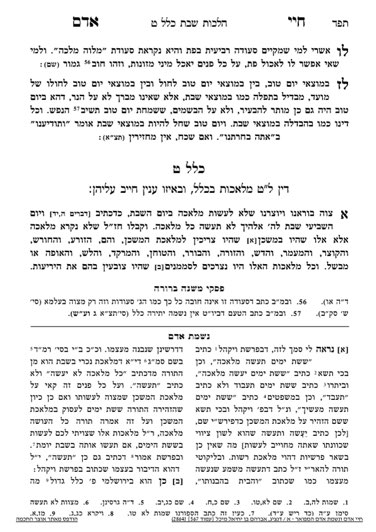We are beginning Klal 9. To review, whereas most seforim divide their content by perakim/simanim and subdivides into seifim, the Chayei Adam divides his content by Klalim and subdivides into simanim.
We are beginning siman 1 in Klal 9. In this Klal, the Chayei Adam discusses the basic yedios a person needs to know regarding Shabbos. The Chayei Adam will begin with a broad overview of the 39 melachos, and will expand on each melacha in later Klalim. In this Klal, after his overview of the melachos, he discusses the idea of avos and toldos, and then discusses davar she’eino miskavein, psik reisha, misaseik, and maaseh Shabbos. Thus, in addition to the melachos themselves, many of the concepts regarding how to deal with the melachos are discussed in this Klal.
The Chayei Adam writes that the Torah prohibits us from performing melacha on Shabbos, as the pasuk says lo sa’aseh kol melacha. The definition of the word melacha is based on actions performed in the mishkan for the purposes of the mishkan. These become the avos melachos which are assur on Shabbos. This is because the Torah prohibited building the mishkan on Shabbos, indicating that the melachos involved in building the mishkan are problematic on Shabbos.
In his peirush on Chumash, Rav Hirsch writes that the word melacha is similar to the word malach, messenger. When a human being takes power and exercises it over the world to create something, they are making the world into their messenger. When a human takes something already in existence and moves it, they are not demonstrating mastery of mankind over the world, as animals can do so as well. It is specifically when one takes the world and manipulates it to do his will that humans demonstrate their mastery over the world, and it is those actions which are defined as melacha and which are assur on Shabbos.
The Gemara in Shabbos, daf 138, teaches that when witnesses were giving hasra’ah (halachic warning) to a person about to transgress Shabbos, they must specify which melacha the person is about to transgress. The Minchas Chinuch understands that if the witnesses give a broad warning of “do not do melacha on Shabbos” the hasra’ah is sufficient. However, if they specify the wrong melacha, it is not a valid hasra’ah. The Tosfos Rid disagrees, and holds that the hasra’ah always has to be specific. In other words, he understands that each of the melachos stand as its own issur in the Torah. Thus, he understand that essentially, there is not one broad issur melacha in the Torah, but 39 issurim of melacha in the Torah.
The issur applies to individuals, to a person vis a vis their children and slaves, and to an owner vis a vis their animals. In all of these, not only may one not do melacha, they may direct or allow the others mentioned in the pasuk to do melacha either.
We will define the 39 melachos in the upcoming shiur, be’ezras Hashem.



